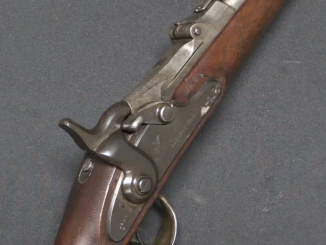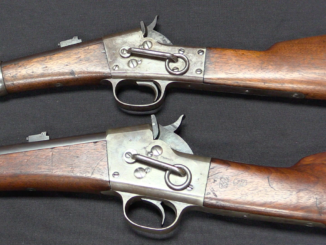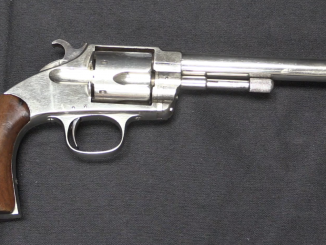At the end of the Great War, the United States sent several thousand soldiers to eastern Siberia, to protect war supplies from the Red Russian forces and to help rescue the Czechoslovak Legion. Also known as the Polar Bear Expedition, this force spent 1919 around Arkhangelsk and Vladivostok. They saw some combat action, and also took on the job of guarding German POWs who had been in Russian captivity. One of those POWs – we will probably never know his name – was a skilled artisan who made fancy custom M1911 grips for a number of American soldiers and officers. They have deep reliefs of eagles and oak leaves and engraved silver plaques. There are at least half a dozen pistols with these grips documented in various collections around the US, and we have two examples to look at in person today.
The wood carvings ing is basically the same on all of them, but the wording on the silver varies from gun to gun. Typically one side has the owner’s name or initials and the other side commemorates the mission, with “AEF” or “Vladivostok” and/or dates of 1919 and 1920. These pistols are a fantastic personal link to a mostly-forgotten corner of US involvement in World War One.




I am most impressed by the checkering below the level of the raised figures, “behind” the imagery.
Were these carved from the original grips or some replacement pieces of wood? The panels look quite thick at their thickest. How were the silver insets attached?
Speaking of the Western Allies in Russia, who wants to talk about Archangel?
“(…)Western Allies in Russia, who wants to talk about Archangel?”
British forces used air-dropped chemical weapons in North Russia 1919
https://simonjoneshistorian.com/2019/08/27/first-air-dropped-cw/
This is Mike Carrick writing. There have been many inquiries about the grips being signed. All four grips have nice smooth rear faces, and there is no mark of any kind on the wood. The method of attaching the silver inlays is a small brass rectangular post soldered (?) to the back of the silver, which is then bent over into the wood. All four are the same, reinforcing the idea that one man made the four grips. Sorry for the late reply. I’ve been away from home for the last two weeks.
“Theo” to “Joe” is not long a leap…
It would be incredible if some researcher could identify that artisan.
I wonder about markings on the underside of the grips…
Phenomenal. Somehow and strangely war and art go together.
The oak leaves betray the carver’s nationality.
“(…)oak leaves betray the carver’s nationality”
???
This symbol appear in 19th century Prussian orders, like Pour le Mérite it was not limited to said country.
Soldiers of the British Empire or the Commonwealth of Nations who are mentioned in dispatches but do not receive a medal for their action, are nonetheless entitled to receive a certificate and wear a decoration. For 1914-1918 and up to 10th August 1920, the decoration consisted of a spray of oak leaves in bronze.
https://www.forces-war-records.co.uk/medals/mentioned-in-despatches-mid
Can be also found in Coat of Arms of the Governorate of Estonia
https://en.wikipedia.org/wiki/Coat_of_arms_of_Estonia
Oak leaves seems to have also special meaning for Serbs as they were featured in emblem used in second half of 20th century
https://en.wikipedia.org/wiki/Coat_of_arms_of_Serbia
To my surprise, I have seen at several occasions, oak leaves motto on memorial ball-caps issued at various occasions in the United States. I did not know before, the Oak tree was a U.S. national tree symbol – if it was.
https://en.wikipedia.org/wiki/Charter_Oak
The Charter Arms company derives its name from this tree.
cheers
eon
Very good explanation. Thank you!
As regards U.S. military Navy Supply Corps in 1922 used following symbol
A sprig of three oak leaves and three acorns, to be embroidered in gold, with an acorn on each side of the stem and one acorn between the two upper leaves, leaves and acorns to be distinctly and separately outlined, except where brought together at the stem of the sprig.
https://scnewsltr.dodlive.mil/Latest-Issue/Article-Display/Article/2612465/evolution-of-the-oak-leaf/
“(…)Somehow and strangely war and art go together.”
Events of Russian Civil War were later often shown in Soviet painting and it was inextricably linked with funding of Soviet Union, as regard foreign intervention see for example http://allart.biz/photos/image/The_interventionists_mercenary_1931.html
Thanks for sharing these pistols!
Part of the 31st Regiment is still around…stationed at Ft. Drum, NY. 4-31 was my old unit. The regiment had a LOT of hard luck historically. Pro Patria is the official motto…the unofficial one was “Polar Bears eat their Young.”
Historical tidbit: one of Polish units in Russian Civil War has trained female white bear, see photo http://www.baskamurmanska.pl/historia-baski-murmanskiej/
“(…)end of the Great War, the United States sent several thousand soldiers to eastern Siberia, to protect war supplies from the Red Russian forces and to help rescue the Czechoslovak Legion. Also known as the Polar Bear Expedition, this force spent 1919 around Arkhangelsk and Vladivostok(…)”
Actually, it was international intervention, it is known as Иностранная военная интервенция в Сибири и на Дальнем Востоке in Russian, which denotes it was intervention of foreign (countries).
https://ru.wikipedia.org/wiki/%D0%98%D0%BD%D0%BE%D1%81%D1%82%D1%80%D0%B0%D0%BD%D0%BD%D0%B0%D1%8F_%D0%B2%D0%BE%D0%B5%D0%BD%D0%BD%D0%B0%D1%8F_%D0%B8%D0%BD%D1%82%D0%B5%D1%80%D0%B2%D0%B5%D0%BD%D1%86%D0%B8%D1%8F_%D0%B2_%D0%A1%D0%B8%D0%B1%D0%B8%D1%80%D0%B8_%D0%B8_%D0%BD%D0%B0_%D0%94%D0%B0%D0%BB%D1%8C%D0%BD%D0%B5%D0%BC_%D0%92%D0%BE%D1%81%D1%82%D0%BE%D0%BA%D0%B5#%D0%A3%D1%87%D0%B0%D1%81%D1%82%D0%BD%D0%B8%D0%BA%D0%B8
gives following participants estimates
73 thousands – Japanese (would later lead to government vs military strained relation)
55 thousands – Czechoslovak (among them would be Czechoslovak prime-minister Jan Syrový and Sergej Vojcechovský and would-be commander of 1. armáda in fateful 1938 year)
12 thousands – Poles
9 thousands – Americans
5 thousands – Chinese
4 thousands – Serbs
4 thousands – Rumanians
4 thousands – Canadians
2 thousands – Italians (see Legione Redenta di Siberia)
1,6 thousands – British
0,7 thousands – French
Interventionist
Details about gen.J.Syrovy https://en.wikipedia.org/wiki/Jan_Syrov%C3%BD
He participated in Czech national awareness famous battle of Zboriv, where he lost his right eye https://en.wikipedia.org/wiki/Battle_of_Zboriv_(1917). The Czech-Slovak brigade significantly aided there to defeat of A-H military.
Addendum Czechoslovak also operated Orlik which has impact of events of Russian Civil War, it history is too long and with too many meanders to describe it here in full details, so I will link to article which should provide good overview for English readers https://medium.com/war-is-boring/a-remarkable-armored-train-fought-its-way-across-eurasia-db3e3180b50c
Your content is truly superb. Please keep up the awesome work.
The stippling (rather than checkering) in the low areas is an old, good dodge for darkening and emphasizing a carved design. My father used it sparingly on some of the rifle stocks he made. If your’re patient, it’s an easy technique, requiring just a needle punch and a hammer.
Those grips look practical, too, although I think they’d let you know when you were shooting hot enough loeads.
I have a carved cigarette box marked US/ East Siberia I picked up at a thrift shop in the late 60’s, it was my joint box when I still indulged in Cannabis.
Oak Leaves and a very Russian looking eagle.
Hi Ian
You seem to be conflating two separate expeditions. The British commanded Allied intervention in North Russia involved the US 339th Infantry regiment while a wholly separate Allied expedition occupied parts of East Siberia. It was the latter which received and shipped out the Czech Legion to France. As a side note, the US 31st Infantry Regiment ended up in Siberia, and both it and the 339th use a polar bear in its insignia. The size of Russis being what it is, the two expeditions never linked up.
Another great episode, whose depth is enhanced by your knowledgeable commenters.
Also: it is time you finished the book on De Gaulle and updated your “sites we enjoy reading.” For example, Weaponsman passed away a couple of years ago.